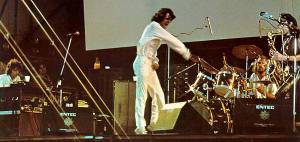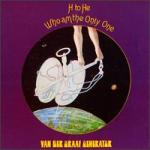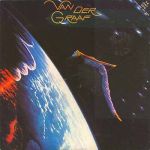 Progressive rock is a very interesting genre, probably because the words combined are actually so general as to be pretty meaningless, and it’s used as a blanket term to cover such a vast array of styles that you can find almost every kind of rock music under this blanket. Hence, who knows what the heck one can expect progressive rock to be? However, there was a time when the term was more appropriate and exact: the glory period from 1969 through, say, 1976, when the musicians who operated under this banner (usually willingly) really were expanding not only the musical dimensions of rock to include influences from myriad other varieties of music-making, but were also expanding the limits of what rock music could express, lyrically and philosophically.
Progressive rock is a very interesting genre, probably because the words combined are actually so general as to be pretty meaningless, and it’s used as a blanket term to cover such a vast array of styles that you can find almost every kind of rock music under this blanket. Hence, who knows what the heck one can expect progressive rock to be? However, there was a time when the term was more appropriate and exact: the glory period from 1969 through, say, 1976, when the musicians who operated under this banner (usually willingly) really were expanding not only the musical dimensions of rock to include influences from myriad other varieties of music-making, but were also expanding the limits of what rock music could express, lyrically and philosophically.
This restless spirit made for some extremely ambitious and brave music, from beautiful idealism to the darkest of pessimism. One group whose oeuvre investigates the darker reaches of the soul is England’s Van der Graaf Generator, a band that justly retains a large cult of followers to this day, as does its lead singer/songwriter Peter Hammill, one of rock’s most prolific and consistently challenging figures. So challenging that to the casual punter he’s still practically unknown but is revered by hardcore musos the world over. His own discography is so vast that I would prefer to defer it for another post, but suffice it to say that he’s continued his explorations in the same vein and beyond in the years since VdGG’s heyday.
Hammill is unapologetically philosophical, and while he’s explored many kinds of lyrical themes in his long career, with Van der Graaf Generator it’s always been ruminations on the dark side of human psychology, the occult, bad religion, weird science, toxic relationships, everything that can disturb and distress. This lyrical fearlessness in investigating the nether reaches of humanity is matched by the musical intensity of the band’s unusual line-up, which, during its most successful period was comprised only of drums, keyboards (mostly organ), sax, and Hammill’s occasional contributions on piano and guitar. Organist Hugh Banton was no Technicolor pixy Hammond tinkler — his organ sound is like a goliath church pipe organ being played in the dead of night in some crumbly old edifice fulla ghouls. And it’s loud! Sax/flute player David Jackson is the cosmic voyager type, sort of like if Hawkwind’s Nik Turner’s sensibility was fused with virtuoso ability, like an Ayler or Coleman. Drummer Guy Evans is one of prog-rock’s more underrated players, adeptly swinging a military grip like a Twilight Zone Levon Helm. On earlier albums there was also a bassist, Nic Potter, though in the mid-seventies, the mega-bass was usually handled by the organ.
 Basically, VdGG’s music was like a big stinkbomb in the middle of the peace and love movement, so it’s not surprising that while the group did have its loyal following (it did keep a “major” recording contract, after all) and its talents were recognized, the uncompromisingly bleak nature of its output (at least on the surface) relegated to the band to perma-cult status. Now, I bet Germans totally got it, though — apparently the Italians did, which makes sense, since they were never scared of big statements.
Basically, VdGG’s music was like a big stinkbomb in the middle of the peace and love movement, so it’s not surprising that while the group did have its loyal following (it did keep a “major” recording contract, after all) and its talents were recognized, the uncompromisingly bleak nature of its output (at least on the surface) relegated to the band to perma-cult status. Now, I bet Germans totally got it, though — apparently the Italians did, which makes sense, since they were never scared of big statements.
All of those aforementioned musicians totally hold up their end of things, but VdGG’s renown is mostly tied to the lyrics and especially the voice of Peter Hammill, subject to much gasping admiration and uncomprehending ridicule over the decades. Hammill’s mega-octave voice is … expressive, shall we say. While capable of great subtlety and some really, really pretty, restrained singing, he’ll often throw off the listener by changing in a split second to an angry, passionate roar with operatic overtones, depending on the lyrical needs of the song. He has never been afraid to express himself to the max, which some people find off-putting, but if you are the sort to appreciate artists who live on the edge, you can’t ask for more. An acquired taste, perhaps, but the size of his cult following indicates it’s a taste a lot of us have acquired. And though darkness was his bag back in the day, we’re not talking twee Gothic nonsense here. Hammill goes right to the heart of the black hole in search of hope, determined to drag some back for those of us brave enough to realize that life is not a happy vision of unicorns and rainbows. This probably explains why he has such a loyal cult of devoted listeners.
The band’s career essentially has three main phases. The first started in the late sixties when VdGG was a psychedelically tinged prog band on the Charisma label with the likes of Genesis. While increasingly dark in tone, the musical is a more typical of the prog of the period, fitting well with King Crimson and bands of that ilk, and usually with more elaborate arrangements than the sparse, spartan and hard-hitting later seventies material. While Hammill was already a dramatic singer, his tone is generally lighter (by his standards).
The band took a hiatus as he started his solo career, then roared back in 1975 with Godbluff, which revealed a new style — the instrumentation stripped back, the tone more aggressive, the lyrics even darker but less florid. It actually approximates the similar journey of Fripp’s lot from the lighter In the Wake of Poseidon to the brutal and heavy Red album several years later. This aggressive sound is probably one of the reasons why VdGG was one of the few prog bands that those snot-nosed punks could stand (part of the VdGG legend is John Lydon’s apparent affection for the band’s work and that Hammill’s angry solo album Nadir’s Big Chance (1975) is considered by some to be an important punk forerunner).
After a brief lineup change that saw Jackson and Banton replaced by String Driven Thing violinist Graham Smith, VdGG broke up again in 1978, but the story wasn’t over. The classic foursome reunited almost twenty years later for the Present album then followed it up with several more (as a three-piece sans Jackson). These albums have proved that things hadn’t changed a bit! The classic heavy, grand sound is still there, and Hammill still spits, roars and croons with the same abandon, thus proving that age is only a number if you refuse to start decaying.
Here are the highlights of the career of this very important band. Unless you insist on your music being as light as a feather at all times, surely you will find something of interest in this very brave discography.
 The Aerosol Grey Machine (1969)
The Aerosol Grey Machine (1969)
The band’s first album is not representative — few really are from that period, if you look at debut albums. It is, however, a nice collection of period piece psych pop that was apparently intended to be a solo debut for Hammill but was changed to a band album. Hammill has yet to discover his gut-wrenching roar, staying up in the pretty, lilty register. The lyrics are already more interesting and a bit darker than the average band of the period (“Necromancer”, “Giant Squid”). More cute than essential but if you love classic psych, you’ll want this album.
 The Least We Can Do Is Wave to Each Other (1970)
The Least We Can Do Is Wave to Each Other (1970)
Van der Graaf Generator starts to get a feel for who they wanna be on this one. A collection of pompous, classical- and jazz-tinged songs still with strong psych influences, it’s very much of its time but already contains some of the trademarks: Hammill’s hyper-dramatic vocals and the omnipresent organ. “White Hammer” is an impressive (and long) tale of witchcraft that features some decent horns as well. “After the Flood” finds the band experimenting with dissonance, but not in a very interesting way — they’d do far better on subsequent albums. This album is worth the price, though, for two tracks: “Darkness (11/11)” has a magnificent tension that doesn’t let up through the whole track, and “Refugees” features what may still be the prettiest melody of Hammill’s career, some lovely strings and organ, and lyrics that are really moving: “West is where all days will someday end / Where the colours turn from grey to gold / And you can be with the friends.” Wonderful.
 H to He Who Am the Only One (1970)
H to He Who Am the Only One (1970)
It’s safe to say that this album is where VdGG really rounds into form, even though it was released close to the previous one — maybe they’d been jamming like mad. This is a very peculiar album, but really, nothing else sounds like it. “Killer” is an overly dramatic tale of underwater serial killing (a metaphor, I assume), but when Jackson goes all free jazz in his sax solo, you can’t help but be impressed. “House With No Door” is a spectral piano-led rumination on mental illness in which Hammill’s voice is at its prettiest. “The Emperor in His War Room” is a bizarre multi-part piece featuring a killer Robert Fripp guest guitar solo, and appears to be based on a surreal novel by Marquez, which I only know because I read the novel and didn’t like it much. The song is much better. By the end, when you think things can’t get more avant-garde and atonal, the sci-fi story of lost astronauts “Pioneers Over C” takes things to the outer limits, alternating between standard tunefulness and full-on experimental music. While there are some immature moments (ie the lyrics to “Killer”), for a second album by a young band this is amazing, especially the ominous, oppressive atmosphere that starts with track one and doesn’t relent.
Many feel this is the band’s best album, and sometimes I agree. Certainly Hammill had figured what he wanted to say by this time, and the band matches this certainty with a set of extremely ambitious pieces, including one of the greatest side-long suites from an era when side-long suites were as common as hip-hop collaborations are today. The impenetrable “A Plague of Lighthouse Keepers” is quite the monolith, not one piece but a suite of linked pieces telling a story intoned commandingly by Hammill through 23 minutes. The main theme features another of his best melodies, and by this time the band could effortlessly move from sweetly melodic to ragingly dissonant at the drop of a hat, one section even devolving into electronic cacophony. Very few experimental groups can do that. The other highlight is “Man-Erg“, a piano ballad that matches “Refugees” for prettiness and drama before an explosive avant-garde middle section rips things up. His lyrics are grand and dark (“A killer lives inside me / Yes, I can feel him move / Sometimes he’s lightly sleeping in the quiet of his room, but then his eyes will rise and stare through mine / he’ll speak my words and slice my mind inside”) but now more mature and genuinely frightening. Prog-rock doesn’t get any more daring than this, and Pawn Hearts is a total success.
VdGG came back from its hiatus leaner and meaner. People who thought the music was dark before must have been surprised that Hammill could find an even darker shade of black (just like the cover!). I mean, death metallers and Goths are indulging in child’s play compared with this, and the reason is they don’t possess his massive intellect. This is smart music as well as bleak, and the band matches the intensity with a new brutalism. Each of these four tracks finds Hammill raging, screaming, and snarling in what has to be one of rock’s greatest primal scream sessions. Witness the thunder of “Scorched Earth” or the uncompromising statement of “The Undercover Man”: “When the madness comes / Let it flood on down and over me sweetly”. By track three, “Arrow“, Hammill’s totally lost his screamy shit and dragged us down with him. Only the pretty intro verses of the concluding “The Sleepwalkers” provide a moment of respite. A classic album indeed.
By this point it almost seems like VdGG had shot its load with those two commanding albums, because this one seems quite self-indulgent, right from the first Euro-prog notes of “When She Comes”. There comes a point when a group with a very distinctive and usually successful sound and vibe passes a boundary and becomes a bit of a parody of itself. While the increased use of quite rockin’ electric guitar on this album is attractive, the tunes sound too much like better ones from the band’s past. Still, there are many enjoyable moments, such as the surprisingly groovy beat and funkiness of “A Place to Survive” and the pretty ballads “Masks” and “Wondering“. Not the place to start, but still a good record when it comes down to it. Still, writing a piece that lionizes your own guitar is a bit self-indulgent.
 The Quiet Zone/The Pleasure Dome (1977)
The Quiet Zone/The Pleasure Dome (1977)
Apparently someone agrees with my sentiments about the last album, because by the time the next one rolled around the band was quite different. Jackson and Banton are gone, replaced by violinist Graham Smith, formerly of String Driven Thing (you may remember “Heartfeeder“, their excellent 1973 song, rather unhinged in its own way) as well as old bass player Potter. Hammill was quite aware of the changing musical landscape, and it had already been reflected in his solo work. This album sounds quite different to Van der Graaf Generator (Hammill had dropped the “Generator” for this one), being based on the violin and acoustic guitar, which is a bit unusual for a set of angular post-punk. It really does feel like a Hammill album, containing some wonderfully taut and lyrically sharp tunes (often about relationships, but in an analytical rather than romantic way) such as “The Habit of the Broken Heart”, “Cat’s Eye/Yellow Fever” and “The Sphinx in the Face“. Still super-dramatic and intense, but in a newer, more futuristic way, this record, along with such solo albums as The Future Now, pointed toward Hammill’s excellent eighties canon, which has not been properly recognized for its quality.
Van der Graaf Generator triumphantly reunited in 2005 and has released four albums, Present, Trisector, A Grounding in Numbers and ALT, but talking about those is for another time this calendar year, cuz this entry’s getting pretty long!





An excellent post indeed. I need to think about a few of the points you make. Much of my youth is locked within this music . . . hmm . . .
LikeLike
Haha, don’t hurt me!
LikeLike
Great essay! Your dates for World Record and Quiet Zone are off by a year, though.
LikeLike
The devil’s in the details! Thanks for pointing that out and thanks for reading.
LikeLike
Pingback: (My) best of RUSH: Canada’s gift to planet Earth | Make Your Own Taste·
Excent post about one of my favorite bands….
LikeLike
Merci!
LikeLike
Very good at French I see!
LikeLike
Thanks for the walk down memory lane. I’ve got them all (including a really bad bootleg). One album you neglected to include is their excellent double live “Vital”. My fav’ number is one called “Door”. For some reason that song wasn’t included on the CD.
LikeLike
Thanks for the comment. I did neglect that album here, but you’ll find a write-up on it in another article: https://makeyourowntaste.com/2013/12/27/double-live-grading-the-glory-of-the-1970s-double-album/
LikeLike